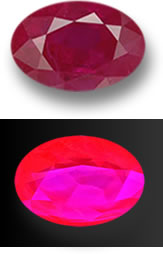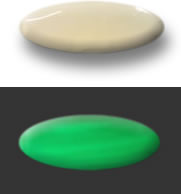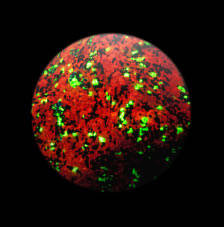|
|
Your Details
|
|
Your Details
|
Reviewed By Andreas Zabczyk
Fluorescent Gemstones A Ruby under Daylight (Top) and UV Light (Bottom)
Fluorescent gemstones are a fascinating category of gems that reveal an entirely new dimension of beauty when exposed to UV light. These stones exhibit a captivating glow, creating an effect known as gemstone fluorescence, which can range from subtle to strikingly vivid. Many collectors and jewelers are drawn to these gemstones for their unique properties, making them a standout choice for distinctive pieces. In this article, we will explore the world of fluorescent gems, providing a detailed fluorescent gemstone list, explaining what gemstone luminescence is, and how this rare phenomenon enhances the allure of various gemstones. For example, a famous blue diamond known as the Hope Diamond fluoresces red. Fluorescent minerals look quite ordinary until ultraviolet light is shone on them, and then they come to life. The magic can be seen when these materials are placed in a dark area under fluorescent light. In the mineral galleries of museums and other such exhibitions, there is often a display of fluorescent minerals where the minerals are lit by an ultraviolet ("UV" or "black") light so that their fluorescence is shown. The fluorescence of minerals may be absent, weak or strong, and may vary in color depending on the specimen. Also, there can be a difference under short-wave and long-wave UV light. Since UV light is not visible to the human eye, the fluorescing materials appear to magically glow in the dark, so these minerals are an amazing spectacle to see. In the Crystal Caves of Australia, the owner has taken this idea even further and has an incredible display of mineral orbs that appear like an "alien galaxy" fluorescing in all the colors of the rainbow. When it comes to fluorescent gemstones, ruby is the best-known gemstone that exhibits red fluorescence. The fluorescence of ruby can be seen somewhat in daylight, since daylight contains some UV light, but to properly appreciate the fluorescence of ruby, artificial UV light is best. Rubies from some sources show a stronger fluorescence than gems from other locations. For example, Siamese ruby has a weaker fluorescence than Burmese ruby. This may be due to the presence of traces of iron. Furthermore, synthetic rubies exhibit a stronger fluorescence than natural stones. Therefore, it can be said that fluorescence as a single tool of identification is unreliable. Calcite can also exhibit pronounced pink to red fluorescence. Additionally, some violet sapphires may show pink to red fluorescence.  A Common Opal under Daylight (Top) and UV Light (Bottom)
Gemstones with yellow to orange fluorescence include some specimens of agate, apatite, sphalerite, scapolite and topaz. Occasionally, colored diamonds also show yellow fluorescence, such as some cognac and orange diamonds. Yellow diamonds can also fluoresce in other colors, such as blue-green. Opal is a gemstone that shows some wonderful play of color (iridescence due to light interference, refraction and diffraction). One of the best examples of the play of color can be seen in the multicolored precious opal gem called the Virgin Rainbow, which was found in an old mineshaft in Coober Pedy in 2003 by John Dunstan. It is believed to be worth over $1 million. Opal not only exhibits play of color, but also sometimes shows green or white to blue fluorescence. Fluorescence is more often seen in common opal, which lacks play of color. One of the best-known and first studied fluorescent minerals is fluorite. Thus, fluorescence itself was named after fluorite in 1852. The colors of fluorite's fluorescence vary depending on the source of the specimen. The color most often seen is blue or purple, but it can also fluoresce yellow, green, red, white and purple. Another interesting fluorite gemstone is color change fluorite, which can change from blue in daylight to purple under incandescent light. Around one third of white diamonds exhibit blue fluorescence, and when diamond fluorescence is very strong, it may make the gemstone appear a little milky in direct light, which is considered unattractive. A benefit of blue fluorescence in diamond is that it can help to disguise yellowish tones, and make the gemstone appear whiter. Benitoite is a rare mineral from California which has a blue fluorescence.  Fluorescent Calcite (Red) and Willemite (Green) Sphere in UV Light
Colored gemstones have always been admired for their wonderful colors and additional optical properties, such as fluorescence make them even more spectacular products of nature. Some mineral enthusiasts enjoy fluorescent materials so much that they are inspired to make their own private collection. While fluorescent minerals are an amazing optical display whichever way they are exhibited, a little imagination in shaping and placement can really bring the specimens to life. With a little careful collecting, a whole rainbow of fluorescence can be acquired. |
